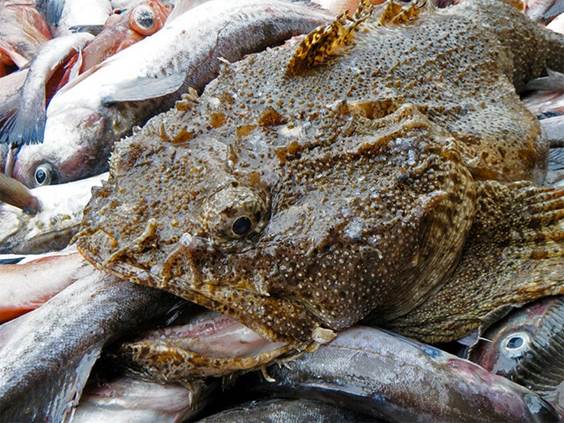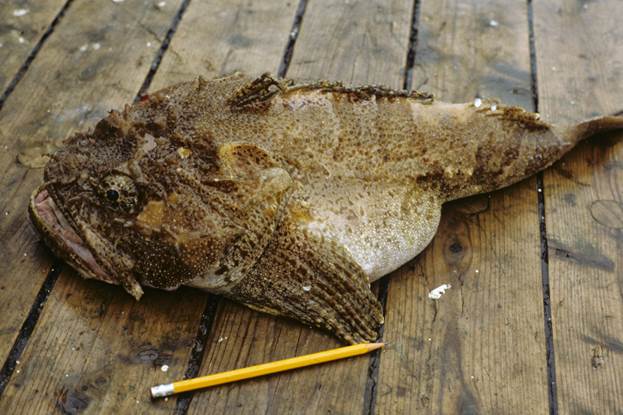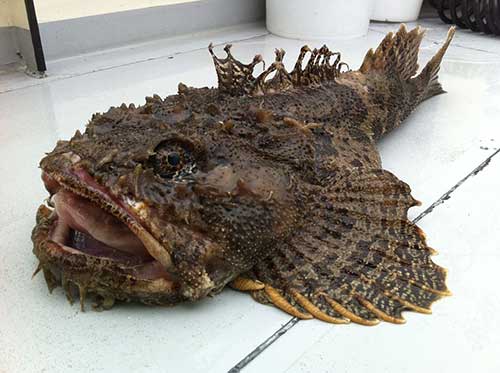I marvel how the fishes live in the sea – Why as men do a-land, the great ones eat up the little ones. William Shakespeare. Pericles, Prince of Tyre
Really – what would you do if you pull this thing into the boat? They are in the sculpin superfamily, Cottoidae, a wide-ranging marine and freshwater fish group. Sculpin are benthic fish – whether in freshwater or saltwater you can find them hanging out along the bottom surface. Big mouth sculpin are large, bottom-dwelling fish that prefer sandy substrates and they often found at depths of around 650 ft. but have been observed as deep as 950 ft.
They are found in the north Pacific from the Bearing Sea through the Aleutian chain and south to Eureka, CA. It is one of the most abundant sculpins in the Bearing Sea with a population estimate exceeding 30,000 metric tons. Washington Department of Fish and Wildlife notes that they are often caught by recreational fishers in Puget Sound – but they don’t actually say if people take them home and eat them.
They are curious looking if you are not familiar with sculpins and have a large mouth and eyes with fleshy nodes on the head and broad pectoral fins. They grow to about 28 inches in length and up to 27 lbs. They are not particularly long-lived – up to 16 years in the wild. It is the largest member of the Genus Myoxocephalus and the second most common fish found in the Bearing Sea.
Great sculpin lie on the bottom and prey upon fish that wander by including pollock, flatfish, other sculpins, and crabs, among others. They are not particularly choosey and have been recorded to eat 150 different prey items. The main prey of big mouth sculpin is pollock, which is more abundant along the shallower coastal shelf zone. Correspondingly, this is where big mouth sculpin grow their largest.
Hemitripterus: Greek, hemi = half + Greek, tres, tria = three + Greek, pteron = wing, fin; bolini:Named after R.L. Bolin, a U.S. ichthyologist.

They are not caught commercially but are often brought up incidentally in the trawl and long-line fisheries of Alaska. Hemitripterids have an interesting reproduction strategy. The males transfer sperm to the females who store with their eggs, which are not fertilized until they mix with the marine waters. Possibly this increases fertilization rate as the sperm is stored in packets of the eggs instead of just releasing the sperm and eggs together in the water where it is subject to currents. Females will then deposit the egg in at least four different species of sponges.
I was lucky enough to see this species regularly while working on a Japanese fishing trawler for a summer in the Gulf of Alaska. After the catch was dumped in the hold, I would wade through knee deep fish to collect my samples for processing. You had to randomly collect fish in selected sample area of the fish bin and fill up these sturdy laundry baskets. You were supposed to just grab fish in your sample area without looking at the fish you were selecting, so not to bias the sample.
Big mouth sculpin would lay in wait with their big maws wide open and if you stuck your hand in one by accident, it one they would quickly snap shut, scaring the bejesus out of you. I’d react quickly, pulling my hand away, often leaving my glove behind and have to yank it back from the sculpin – or I would reactively fling one of these guys across the bin as it hung on to my fingers. My Japanese shipmates showed me an entertaining trick — where you would take a small-sized, big mouth sculpin and stick its tail in a slightly larger, one who would then chomp down on it. You could put together a string of 6 or 7 big mouth sculpin this way and then lift them all like a big daisy chain.
There were some long days aboard ship, so you had to find your entertainment when you could.

